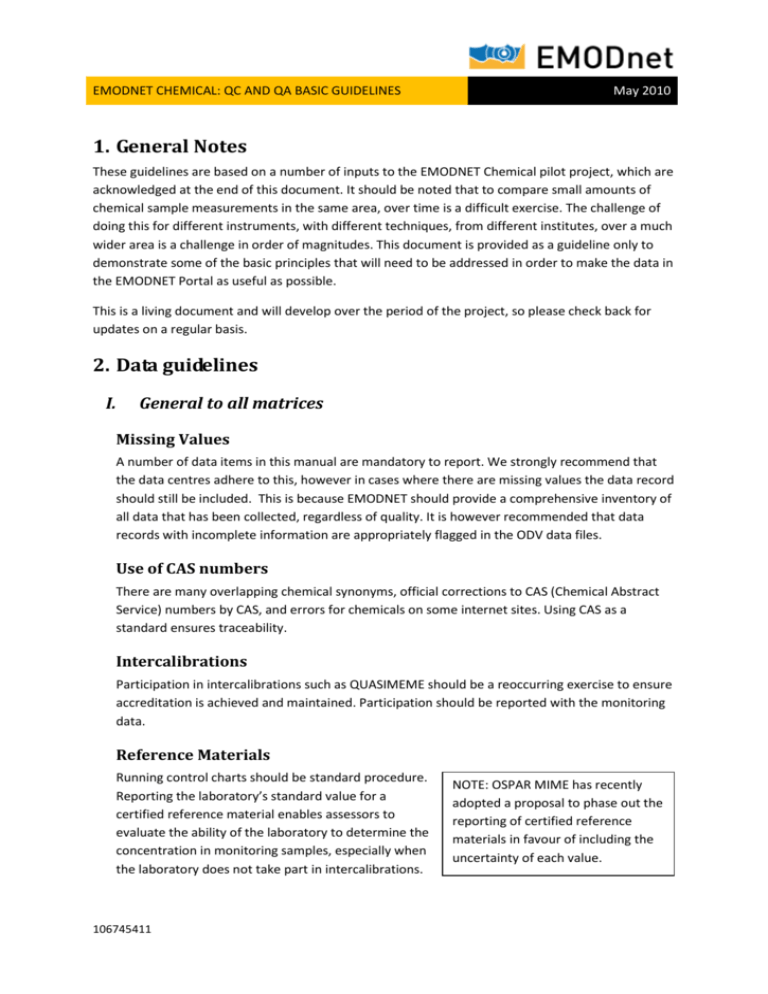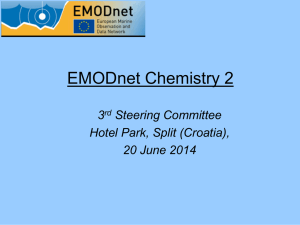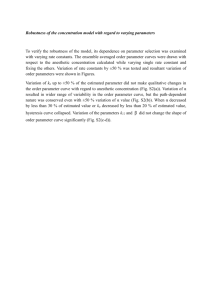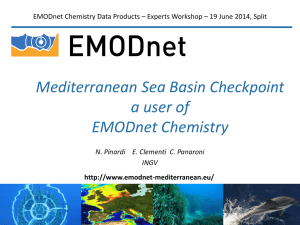EMODNET Chemical: QC and QA basic guidelines
advertisement

EMODNET CHEMICAL: QC AND QA BASIC GUIDELINES
May 2010
1. General Notes
These guidelines are based on a number of inputs to the EMODNET Chemical pilot project, which are
acknowledged at the end of this document. It should be noted that to compare small amounts of
chemical sample measurements in the same area, over time is a difficult exercise. The challenge of
doing this for different instruments, with different techniques, from different institutes, over a much
wider area is a challenge in order of magnitudes. This document is provided as a guideline only to
demonstrate some of the basic principles that will need to be addressed in order to make the data in
the EMODNET Portal as useful as possible.
This is a living document and will develop over the period of the project, so please check back for
updates on a regular basis.
2. Data guidelines
I.
General to all matrices
Missing Values
A number of data items in this manual are mandatory to report. We strongly recommend that
the data centres adhere to this, however in cases where there are missing values the data record
should still be included. This is because EMODNET should provide a comprehensive inventory of
all data that has been collected, regardless of quality. It is however recommended that data
records with incomplete information are appropriately flagged in the ODV data files.
Use of CAS numbers
There are many overlapping chemical synonyms, official corrections to CAS (Chemical Abstract
Service) numbers by CAS, and errors for chemicals on some internet sites. Using CAS as a
standard ensures traceability.
Intercalibrations
Participation in intercalibrations such as QUASIMEME should be a reoccurring exercise to ensure
accreditation is achieved and maintained. Participation should be reported with the monitoring
data.
Reference Materials
Running control charts should be standard procedure.
Reporting the laboratory’s standard value for a
certified reference material enables assessors to
evaluate the ability of the laboratory to determine the
concentration in monitoring samples, especially when
the laboratory does not take part in intercalibrations.
106745411
NOTE: OSPAR MIME has recently
adopted a proposal to phase out the
reporting of certified reference
materials in favour of including the
uncertainty of each value.
EMODNET CHEMICAL: QC AND QA BASIC GUIDELINES
May 2010
Uncertainty
Uncertainty of the value should be reported. If uncertainty is reported, then the method of
calculation must also be reported.
Temporal accuracy
For historical data – where the dates were not accurately registered, it is acceptable to provide
the value with no month or day. This should be flagged in the quality flag system.
Code lists
See section on Controlled Vocabularies
Data must comply with the accepted code lists and fields marked as mandatory must be
supplied with legal values.
Cruise ID’s
Must be unique within data reported by a distinct organisation for a specific dataset.
Basis (of determination)
Basis is mandatory for all organic and inorganic contaminants in sediment, seawater and biota.
Note that basis forms a component of the P011 vocabulary.
The same basis and unit should be consistently reported for yearly trend series. Unit vs Basis are
checked against year-1 submission to flag changes in reported Basis, which can influence the
quality of trend analysis.
See also Basis Calculation conversion.
Depth
Depth of samples should be reported. If reported, lower depth cannot be greater than upper
depth.
II.
Meta-data requirements
Purpose of Monitoring
Purpose of monitoring is mandatory since not all types of monitoring samples can be combined
in a trend series. For example, samples taken for a one-off research survey would be excluded
from a 10 year temporal trend analysis. Therefore meta-data information is needed and will
create a warning if not reported. See SeaDataNet vocabulary (C342) Monitoring activity
rationale.
106745411
EMODNET CHEMICAL: QC AND QA BASIC GUIDELINES
May 2010
Station Names
This must be reported for monitoring data. Both OSPAR and HELCOM use the ICES Station
Dictionary to control their meta-data information regarding stations. This allows the grouping of
samples over a period of time for trend analysis. Although stations can in theory be identified by
their coordinates, it is often very difficult to reconcile over a period of time due to
station/species drift, changes to monitoring programme sampling procedures and other factors.
Sampling method and instrument
To ensure comparability, sampling method should be reported. In addition, the instrument of
sampling must also be reported, see SeaDataNet list (L051) sample collector categories.
Method of Analysis
This must be reported. This is an element of the parameter in the SeaDataNet P011 vocabulary.
Method of Filtration for trace metals
This must be reported for water column. This is an element of the parameter in the SeaDataNet
P011 vocabulary.
Method of chemical extraction
This must be reported for sediment data. This is an element of the parameter in the SeaDataNet
P011 vocabulary.
Limit of detection/limit of determination
Report the limit of detection for the parameter concerned according to the method of analysis
used. The value must be reported in the units for the parameter concerned, and on the
appropriate basis of determination.
The limit of detection, or LOD, is defined as that concentration of analyte which yields an analytical
response equal to three times the standard deviation of the complete procedural blank - or a sample
with a very low concentration of the analyte (as sometimes spiking is necessary in order for a
response to be detectable).
III.
Biota
Species
Species must match to the European Register of Marine Species (ERMS) or ITIS (Taxonomic
Information System). Ordinarily, the taxonomic list that was used should be reported with the
species.
Check maximum range for age, length and weight of species for outliers.
106745411
EMODNET CHEMICAL: QC AND QA BASIC GUIDELINES
May 2010
Number of Individuals
Number of individuals in a biota sample is mandatory. The number of individuals required to
comprise a “sample” is/should be defined by the monitoring programme.
Length and Weight
Check length and weight parameter values reported for a whole organism against parameter
values reported in their respective tissue. With shellfish, consistently report if the whole
organism includes the shell.
Tissue
Reporting the tissue (or fraction of tissue) is mandatory. This is an element of the parameter in
the SeaDataNet P011 vocabulary. When pooling tissue, report the number included.
IV.
Water
Method of Filtration for trace metals
This must be reported for water column. This is an element of the parameter in the SeaDataNet
P011 vocabulary.
Suspended Particulate Matter (SPM)
When reporting metal concentration in suspended particulate matter, report the metal
concentration on a dry weight basis and also report the total concentration of suspended
matter.
V.
Sediment
Method of chemical extraction
This must be reported for sediment data. This is an element of the parameter in the SeaDataNet
P011 vocabulary.
Grain Size
When reporting a metal concentration, it is mandatory to report the fraction analysed, i.e., the
grain size of the fractionated sample. This is an element of the parameter in the SeaDataNet
P011 vocabulary.
Normalisers
When reporting metals, the reporting of normalisers (organic carbon, aluminium) and dry weight
% are also mandatory. See Normalisation.
106745411
EMODNET CHEMICAL: QC AND QA BASIC GUIDELINES
May 2010
3. Controlled Vocabularies
The SeaDataNet vocabularies will be the provider of lists and definitions for the EMODNET Chemical
pilot.
VI.
Parameters
Detailed parameters are defined in the SDN P011 list, and further mapping information is
available on the EMODNET chemical extranet.
P021 list:
http://seadatanet.maris2.nl/v_bodc_vocab/search.asp?name=(P011)%20BODC+Parameter+Usa
ge+Vocabulary&l=P011
EMODNET Chemical Parameter mapping:
http://nodc.ogs.trieste.it/emodoc/Parameter_mappings_P011.xls
Data submitters should note that the parameter defined in the P011 list is not a single entity but
really a combination of elements, that together
NOTE: Data submitters should therefore
make up a parameter in this context. Simply
take special care that the P011 terms
explained:
they map to are correct and where
[Measurement] + [Chemical] + [Unit] + [Matrix] +
necessary propose new terms to P011 to
[Phase] + [Method] + =
account for parameter combinations not
already in existence. DO NOT MAP TO A
P011 parameter term =
‘NEAR’ MATCH
“Concentration of mercury (Hg) per unit dry weight
of biota {Mytilus galloprovincialis (ITIS: 79456: WoRMS 140481) [Subcomponent: flesh]}”
Special care should be taken when reporting parameters expressed as ions, for example
Tributyltin can be expressed as an ion (CAS 36643-28-4).
VII.
Units
Units are defined in the SDN P061 list, the mapping of these units to the parameter grouping
(P021) has been made available on the EMODNET chemical extranet.
P021 -> P061
http://nodc.ogs.trieste.it/emodoc/EMODNET_Parameter_Units_P021_P061new.xls
Parameters should be reported in the preferred unit selected for the EMODNET Chemical pilot.
In cases where this is not possible, the original unit should be reported with supporting
information, such as basis of determination (wet weight, dry weight) that will allow proper
interpretation of the data.
106745411
EMODNET CHEMICAL: QC AND QA BASIC GUIDELINES
May 2010
4. Normalisation (by sampling matrix)
When attempting to assess the concentration of parameters from different geographical areas, it is
essential that these data are comparable. Minimising the natural variation in time and space due to
confounding factors is achieved via normalisation which can be done by various methods. Thus,
when reporting contaminant data in environmental matrices it is critical to also report cofactor data
and key method information to enable interpretation.
I.
Sediment
When analysing parameters in sediment, concentrations should be expressed as dry matter or
accompanied by dry weight content since the variable adhering water is not part of the
sediment. The second equally or more important issue is that contaminants in sediments are
primarily bound to the fine material and sand grains are essentially diluting the sample. The
same concentration of a toxic compound in sandy sediment has a much higher risk than when
sorbed to a clay-like sediment. Therefore it is a prerequisite to consider the composition of
sediment with regard to the sorption capacity when assessing the quality of sediments on a
spatial or time scale. This can be done by normalising the measured concentrations using
cofactors that represent the properties of sediment in terms of uptake capacity. Cofactors that
can be used are the aluminum or lithium content when it concerns heavy metals and organic
carbon for organic contaminants.
Another widely used method is testing sediment samples of similar composition by removal of
sand particles. Typically the sieved fraction of less than 63 or 20µm is analysed. The obtained
fine fraction has a composition that varies much less in time and space than the original
samples. In a spatial sense normalisation still compares apples and pears, but, without
normalisation, apples and elephants are compared.
II.
Biota
Concentrations in biological tissues can be expressed in several ways. In general, concentrations
are expressed on fresh weight, dry weight or lipid weight. The basis is entirely dependent on the
goal. For food consumption it makes perfect sense to express concentrations on a fresh weight
basis as this is what is actually taken up by the consumer. Exposure of, for instance, marine
mammals could also be approached in this fashion. Comparing environmental concentrations or
performing trend analysis is an entirely different matter. In that case, one will try to limit the
differences caused by factors that are inherent to tissues or species.
One major factor is the lipid content. Lipid contents may vary considerably within individuals of
the same population and across populations. Contaminants, such as organic substances, are
associated with lipids and one runs the risk of observing differences purely based on differences
in the lipid content when concentrations are expressed on a fresh weight basis. If the objective is
to assess the environmental status of a region, the evolution in time of contaminants or to
compare the same species across different regions, it is absolutely essential that any variability
or differences caused by a factor such as the lipid content is taken out of the picture.
106745411
EMODNET CHEMICAL: QC AND QA BASIC GUIDELINES
May 2010
Another example is the water content of shellfish, a parameter that tends to vary considerably
due to the processing of shellfish samples. To compensate for this, shellfish contaminant data is
generally expressed, for environmental purposes, on a dry weight basis. Finally, in any program a
common policy regarding reporting units is essential and will be linked to the purpose of the
program (health protection, trend analysis, environmental status assessment). Essential
information such as the lipid content and dry weight content, should always accompany the
data.
III.
Water
Water concentrations may be reported as dissolved concentrations (filtered) or as total
concentrations. This needs to be clearly defined for the sample and suspended matter content
should also be reported to facilitate interpretation.
106745411
EMODNET CHEMICAL: QC AND QA BASIC GUIDELINES
5. Acknowledgements
With thanks for guidance and input from:
ICES Marine Chemistry Working Group (MCWG)
http://www.ices.dk/workinggroups/ViewWorkingGroup.aspx?ID=20
OSPAR Monitoring and Assessment Group (OSPAR MON/MIME)
http://www.ospar.org/
SeaDataNet Technical Task Team
http://www.seadatanet.org/
HELCOM Monitoring and Assessment (MONAS)
http://www.helcom.fi/groups/monas/CombineManual/en_GB/Contents/
ICES Data Centre
http://www.ices.dk/datacentre
QUASIMEME
http://www.quasimeme.org/
Biological Effects Quality Assurance in Monitoring Programmes (BEQUALM
http://www.bequalm.org/QA_programme.htm
106745411
May 2010
EMODNET CHEMICAL: QC AND QA BASIC GUIDELINES
May 2010
1. Basis calculation conversion
Logic for Fat Weight Percentage (FATWT%), Lipid weight percentage (LIPIDWT%) and Extractablelipid percentage (EXLIP%).
If FATWT% is reported use else if LIPIDWT% is reported use it else if EXLIP% is reported use it.
FATWT% and LIPIDWT% are comparable, but EXLIP% should have a lower priority.
Case 1: dry weight (D): metals, organotins, organochlorines and PAHs in bivalve soft body tissues
WHEN 'D' is reported THEN @VALUE
WHEN 'W' is reported THEN @VALUE*(100/DRYWT%)
(if DRYWT% is missing, NULL is reported)
WHEN 'L' is reported THEN VALUE*(FATWT%/DRYWT%)
(if FATWT% is missing, use LIPIDWT%, if LIPIDWT% is missing use EXLIP%, otherwise NULL)
Case 2: wet weight (W): metals and organochlorines, organotins in fish muscle and tail muscle
(crustaceans), metals and organotins in fish liver
WHEN 'W' is reported THEN @VALUE
WHEN 'L' is reported THEN @VALUE*(FATWT%/100)
(if FATWT% is missing, use LIPIDWT%,if LIPIDWT% is missing use EXLIP%, otherwise NULL)
WHEN 'D' is reported THEN @VALUE*(DRYWT%/100)
Case 3: lipid weight (L): organochlorines in fish liver
WHEN 'L' is reported THEN @VALUE
WHEN 'W' is reported THEN @VALUE*(100/FATWT%)
(if FATWT% is missing, use LIPIDWT%,if LIPIDWT% is missing use EXLIP%, otherwise NULL)
WHEN 'D' is reported THEN @VALUE*(DRYWT%/FATWT%)
(If FATWT% is missing,use LIPIDWT%,if LIPIDWT% is missing use EXLIP%, otherwise NULL)
106745411
EMODNET CHEMICAL: QC AND QA BASIC GUIDELINES
2. Document Version History
21 May 2010
V1.1 First version developed by ICES released to EMODNET Chemical Portal
3 June 2010
V1.2
106745411
New text under 3.VII Units
Added new text concerning missing values under 2. I
May 2010






